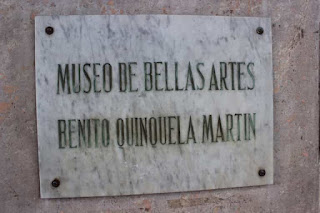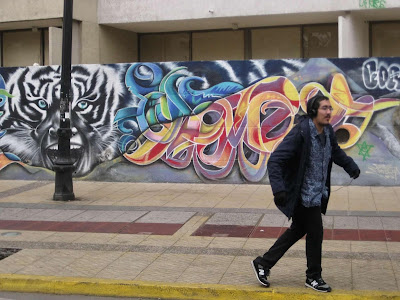 The only word in the title that might give non-Spanish speakers any difficulty is Sueño, and the poster on the left should clear that up.
The only word in the title that might give non-Spanish speakers any difficulty is Sueño, and the poster on the left should clear that up. This post is based on an exhibit at the Skirball Cultural Center in Los Angeles. We went because they have an excellent children's space called Noah's Ark which I've posted about before.
There was enough for four or five posts, and given I still have grandchildren around, I'm just going to focus on one and try to get this done quickly.
Here's the artist's statement. I saved it in higher than normal resolution in hopes you could read it.
Let me highlight this paragraph:
"These confiscations struck me as wrong. The cruelty of stripping away such personal items from vulnerable people is dehumanizing, both to those whose belongings are taken and to those who enforce the policy."
 |
| Combs and Brushes |
A few things here:
- The artist, Tom Kiefer, started this in 2007, during the 2nd Bush administration, so dehumanizing immigrants isn't something that began under Trump.
- As someone who worked at a US Border Control Facility, he noted that it dehumanized the officials who enforced these policies as well as the victims.
And people are leaving ICE. From the Los Angeles Times in January 2019:
"In March 2017, McAleenan said Customs and Border Protection normally loses about 1,380 agents a year as agents retire, quit for better-paying jobs or move. Just filling that hole each year has strained resources."This is from an article that is focused on recruitment:
"In a sign of the difficulties, Customs and Border Protection allocated $60.7 million to Accenture Federal Services, a management consulting firm, as part of a $297-million contract to recruit, vet and hire 7,500 border officers over five years, but the company has produced only 33 new hires so far. " [Emphasis Added]
 |
| Some Items Confiscated |
A large percentage of ICE agents are Latinx according to this Pacific Standard article by Khushbu Shah. He reports on the 100 interviews by Assistant Professor David Cortez who examined the relationships these officers have with their jobs and why do their jobs.
"Cortez has found that many of the agents he spoke with drew a distinct line between their empathy and their careers. A Latino agent in Texas recently told Cortez he is aware that he might be on the wrong side of history, but the money was too good to quit. The cities where many of the agents come from in the Rio Grande Valley are some of the poorest in the state of Texas, a state in which nearly one in five people lives below the poverty line. The starting salary, in turn, under Customs and Border Protection is nearly $56,000, well above the region's median household income of $34,000."
This is the inscription plate from a bible with notes on travel through the desert and other dates and notes.
 |
| Gloves |
These are pain tablets.
It's important to remember that the oppressor is dehumanized as much as the oppressed.
And to connect a few more dots, the breaking of unions has allowed the lowering of salaries for many jobs as well as the loss of health benefits and pensions. And these conditions make it easier to recruit people into the military and other sorts of occupations where people are dehumanized.
And today is nearly the end of 2019 and we're just seeing these images, which began in 2007, now, 12 years later. Justice takes so much longer than the original acts of abuse and criminality.




















































